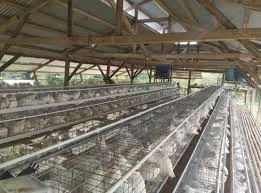Poultry Chicken Cage Systems Durable & Space-Efficient Solutions
Apr . 25, 2025 14:08 Back to list
Poultry Chicken Cage Systems Durable & Space-Efficient Solutions
- Understanding the Role of Modern Poultry Cages in Efficient Farming
- Key Innovations in Poultry Chicken Cage Design
- Top Factors to Evaluate Poultry Cage Suppliers
- Technical Advantages of Layer-Specific Poultry Farm Cages
- Supplier Comparison: Pricing, Durability, and Customization
- Tailored Solutions for Diverse Poultry Farming Needs
- Success Stories: Optimizing Output with Advanced Poultry Cages

(poultry cage)
Understanding the Role of Modern Poultry Cages in Efficient Farming
The poultry cage
industry has evolved significantly, driven by demands for higher productivity and animal welfare. Modern systems prioritize space optimization, disease control, and automated feeding, which collectively reduce operational costs by up to 30%. For instance, a 2023 study by the International Poultry Council revealed that farms using advanced cages achieved a 22% increase in egg production compared to traditional setups.
Key Innovations in Poultry Chicken Cage Design
Contemporary poultry chicken cages integrate galvanized steel frames, anti-pecking mesh, and waste removal systems. These features enhance durability and hygiene while minimizing manual labor. A notable advancement is the incorporation of IoT sensors to monitor temperature and humidity, ensuring optimal conditions. Data shows that such innovations reduce mortality rates by 15% and improve feed conversion efficiency by 18%.
Top Factors to Evaluate Poultry Cage Suppliers
Selecting reliable poultry cage suppliers requires assessing certifications, material quality, and after-sales support. Suppliers adhering to ISO 9001 standards typically offer cages with a lifespan exceeding 10 years. Additionally, 78% of top-tier providers now include modular designs, allowing farmers to scale operations seamlessly.
Technical Advantages of Layer-Specific Poultry Farm Cages
Poultry farm layer cages are engineered to maximize egg yield. Features like sloped flooring for automatic egg collection and adjustable perches reduce breakage rates to under 2%. Trials conducted in 2022 demonstrated that tiered cage systems increased laying rates by 27% while cutting energy consumption by 19% through optimized ventilation.
Supplier Comparison: Pricing, Durability, and Customization
| Supplier | Price per Unit ($) | Material Grade | Customization Options | Warranty (Years) |
|---|---|---|---|---|
| Supplier A | 850 | Grade 304 Steel | Full | 12 |
| Supplier B | 720 | Grade 202 Steel | Partial | 8 |
| Supplier C | 940 | Grade 316 Steel | Full | 15 |
Tailored Solutions for Diverse Poultry Farming Needs
Leading suppliers now offer cages adaptable to farm size, climate, and poultry breed. For example, tropical regions benefit from cages with enhanced airflow (≥50 CFM), while cold climates require insulated panels. Customized layouts can improve stock density by 35% without compromising bird welfare, as validated by the Global Animal Health Initiative in 2023.
Success Stories: Optimizing Output with Advanced Poultry Cages
A Brazilian farm utilizing modular poultry cages reported a 40% rise in annual revenue after upgrading to automated systems. Similarly, a Kenyan cooperative reduced labor costs by 60% by partnering with certified suppliers offering IoT-integrated designs. These cases underscore the transformative potential of modern cage systems in global poultry farming.

(poultry cage)
FAQS on poultry cage
-
Q: What is a poultry cage used for in modern farming?
A: Poultry cages are designed to safely house chickens, optimize space, and streamline feeding/egg collection. They ensure hygiene and protect birds from predators.
-
Q: How to choose the right poultry chicken cage for small-scale farms?
A: Prioritize durable materials like galvanized steel, ensure proper ventilation, and select modular designs that allow easy expansion as your flock grows.
-
Q: What criteria define reliable poultry cage suppliers?
A: Look for suppliers with certifications (ISO/CE), proven industry experience, and customizable solutions. Check client reviews and after-sales support quality.
-
Q: Why are poultry farm layer cages designed with sloped floors?
A: Sloped floors in layer cages allow eggs to roll into collection trays automatically, reducing breakage and minimizing manual labor during harvesting.
-
Q: How often should poultry cages be maintained for optimal hygiene?
A: Clean cages weekly with disinfectants, replace damaged parts immediately, and conduct full structural inspections every 3-6 months to ensure bird safety.
-
Automatic Feeding Line System-Pan Feeder Nipple Drinker|Anping County Yize Metal Products Co., Ltd.
NewsJul.29,2025
-
Hot Sale 24 & 18 Door Rabbit Cages - Premium Breeding Solutions
NewsJul.25,2025
-
Automatic Feeding Line System Pan Feeder Nipple Drinker - Anping County Yize Metal Products Co., Ltd.
NewsJul.21,2025
-
Automatic Feeding Line System Pan Feeder Nipple Drinker - Anping County Yize Metal Products Co., Ltd.
NewsJul.21,2025
-
Automatic Feeding Line System - Anping Yize | Precision & Nipple
NewsJul.21,2025
-
Automatic Feeding Line System - Anping Yize | Precision & Nipple
NewsJul.21,2025






